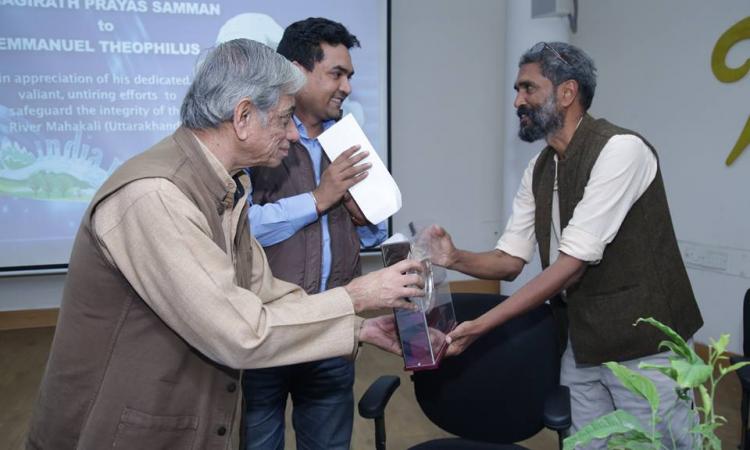
The epic voyage--Nadisutra--along the Ganga may have been the high point of Emmanuel Theophilus’s recent work, but there have been many more peaks and valleys for this fervent mountaineer cum ecologist. Theo lives in a remote village near Munsiyari in Uttarakhand. Once a full-time employee of the National Dairy Development Board and later of its offshoot National Tree Growers’ Cooperative Federation, he went to work with the Foundation for Ecological Security, a national NGO. Most of his work since 1992 on ecological restoration and conservation of land and water resources is based in Munsiyari along the mountain river Goriganga, a part of the Mahakali river system.
In one of his writings in Seminar (2010) ‘A river, for now’, Theo tells the story of the Goriganga river in the Western Himalayas. The river ran ‘free’--not much altered by human interventions--but is off late witness to the ‘development’ drama unfolding in this eco-fragile region. As many as 30 projects are proposed to be constructed over 100 km. He calls this the “story of the damming of the Gori – a tale of political and bureaucratic hubris”. Hydropower, a source of ‘clean’ energy was proposed to be developed by the Government of Uttarakhand. As a part of this, a series of dams were to be built on almost every single river and tributary.
Theo goes on to discuss the impacts that the deployment of alternative, relatively carbon-neutral technology has on nature, as also on human communities. He laments that even minimum vital flows essential to sustain life in the rivers will not be allowed with the building of these run-of-river dams and diversion tunnels as this would alter the volumes and seasonal rhythms of water flowing in the river and its tributaries. In his speech at India Rivers Day 2015, Theo expressed his concern for the cumulative impact on flow volumes and connectivity by the construction of series of dams. He had predicted that episodic floods can be of magnitudes difficult to comprehend, and the Uttarakhand flood of 2013 proved his point.
His work centres on the impacts of ‘development’ on river systems, more importantly its ecology. In his 2014 report titled ‘Headwater Extinctions’ for SANDRP, Theo dealt with the impacts of hydropower projects in the Beas basin in Himachal Pradesh and the Alaknanda-Bhagirathi basins in Uttarakhand on river ecosystems and its components, mainly fish. “While the harrowing impacts of hydropower projects on local livelihoods and social systems are being realised gradually, we are yet unclear about the extent of impacts of these so-called green projects on fish and aquatic biodiversity”, he states.
Nadisutra: Kayaking down to tell a river's story
In late 2014, he and his young son Zanskar set sail on a 2000 km long journey along the Ganga in a tiny kayak pitting their grit against the mighty river. They began from the headwaters of the Mahakali River in Uttarakhand, going down the Karnalii-Sarda-Ghagra-Sarju system and then setting foot in the Ganga. Sailing along Ganga’s distributary Hooghly, they reached the sea at Sagar Island. Supported by organisations like Himal Prakriti, World Wildlife Fund-India and India Water Portal, the father-son duo made this grand expedition camping on small islands. Having spent days and nights on the Ganga he says that “the river is dying, and is near-dead in sections now”.
Interlinking of rivers has been another of his concerns. Speaking at India Rivers Day 2015, he dealt with the disastrous project as a part of which water from the Sharda-Yamuna and Ghagra-Yamuna links are to be diverted as far as the Sabarmati and the Chambal. “Rivers must be seen in their continuum”, is the lesson to be learnt from this. Meanwhile, we await his forthcoming work on the modern ecological history of the Mahakali River.